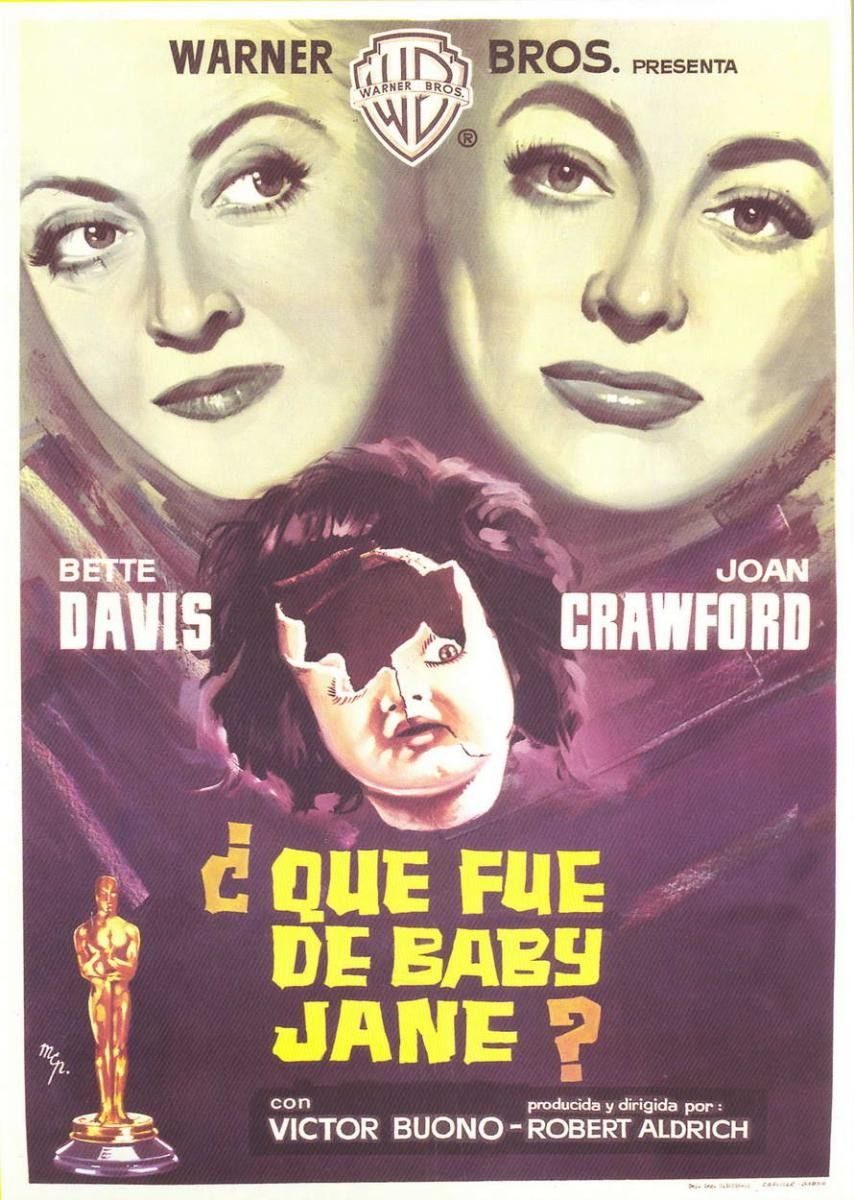by KEM Huntley
“Want to see it again little girl? It shouldn’t frighten you.” The opening scene of a crying Jack in the Box toy forebodes the strangeness yet to come.
Director Robert Aldrich and writer Lukas Heller’s What Ever Happened to Baby Jane? (based on a novel by Henry Farrell), is classic horror saved from camp by its fine performances. The story of sibling rivalry gone mad necessitates the highly wrought performances from its lead actresses, Bette Davis and Joan Crawford. The sparse supporting cast play their individual parts with enough verve to make them memorable, yet with the restraint required to allow two of Hollywood’s Grande Dames fued.
In 1917, Baby Jane Hudson (main character) is a wildly popular child song and dance act on the vaudeville circuit. Tyrannical behind the scenes, her heart belongs to daddy and her earnings support the show business family. “I want an ice cream. . . . I want it! I make the money so I can have what I want.”
Mother understands (overall story consequence) Jane’s stardom will be short lived, and the real talent lies in big sister Blanche (impact character).
MOTHER
You’re the lucky one Blanche, really you are. Someday it’s going to be you that’s getting all the attention (impact character benchmark-future). And when that happens, I want you to try to be kinder to Jane and your father than they are to you now. . . . I hope you’ll try and remember that (overall story dividend-memory).
Bitterly, Blanche replies: “I won’t forget. You bet I won’t forget!”
Cut to 1935. Baby Jane is a B movie actress. Blanche, “the biggest thing in movies today.” Blanche has the clout to insist (impact character unique ability-interdiction) Jane receive film work—much to the chagrin of the industry:
PROJECTIONIST 1
When the old man hired the Hudson sisters, how come he had to hire the back end of the act too? Boy, what a no-talent broad that Baby Jane is.
PROJECTIONIST 2
Why can’t she stay sober?
Later, a studio head remarks: “She [Blanche] ought to have sense (relationship story thematic issue) enough to know that she can’t make a star out of Baby Jane again.”
Up to this point, enough information is given to provide backstory for the sisters’ twisted relationship. The next scene is an automobile pulling up to the Hudson residence—one sister opens the gate, the other attempts to run her down (story driver-action). A shriek and a sob and the credits open the film to present day.
Blanche is bound physically to a wheelchair (impact character domain-universe); Jane bound emotionally to her sister by guilt (relationship story domain-physics). They live as recluses with intermittent household help. Nosy Parker neighbor comments: “How come we never see her [Blanche] around? We’ve been living next door (overall thematic issue-situation) for six months now, and the only one I ever see is that fat sister slouching around. Don’t they ever have company? . . . Julie says that sister is kind of peculiar (main character thematic issue-suspicion). . . she’s supposed to be (overall problem-perception) responsible for the accident that crippled her sister Blanche.”
The local television station is broadcasting (impact character signpost 1-present) Blanche’s classic films (impact character concern-past), an event that pleases her, yet raises Jane’s ire (relationship story symptom-self-aware; overall story catalyst-circumstances). A vitriolic alcoholic (overall story symptom-chaos), Jane’s increasing jealousy (main character benchmark-subconscious) and strange behavior (overall story domain-psychology) is cause for Elvira, the Hudson’s’ housekeeper, to prod Blanche to sell the house and conceptualize (overall story goal) a way to put Jane “where they can look after her properly.”
BLANCHE
We’ll probably have to sell the house.
JANE
When did our business manager tell you all this?
BLANCHE
Early last week, I think.
JANE
. . . Oh you’re a liar. You’re just a liar! You always were (impact character solution-actuality). . . . Don’t you think I know everything that goes on in this house (relationship story response-aware)? . . . Blanche, you aren’t ever going to sell this house (relationship story inhibitor-destiny).
Jane, furious, disconnects Blanche’s bedroom telephone (relationship story thematic issue-senses) and serves up a dead pet bird for lunch.
Determined (main character domain-mind) to make a comeback (main character critical flaw-sense of self), Jane places an ad in the personals to hire a musical accompanist. She equivocates to Elvira to keep her out of the way—and away from interfering with Blanche:
JANE
You can have the whole day off.
ELVIRA
Well thanks, but does . . . Miss Blanche know about my taking the day off?
JANE
Oh sure, she knows (overall story inhibitor-falsehood).
Jane receives her gentleman caller garishly made up and dressed in ghastly Baby Jane apparel. Edwin, a musician and mama’s boy, is a bit of a con artist (overall story signpost 3-being). Financial circumstances (overall story catalyst) have compelled him to answer Jane’s ad. He overlooks Jane’s bizarre behavior-intent on following his own agenda (overall story concern-psychology).
JANE
I’m Baby Jane Hudson.
EDWIN
(Taken aback. He obviously has no clue who she is. He makes a quick recovery.)
Oh. Do you mean you’re really the Baby Jane Hudson?
JANE
Yes I am. And I’m going to revive my act exactly as I used to do it. Of course some of the arrangements will have to be brought up to date. Music changes (main character problem) so much, doesn’t it? . . . There are a lot of people who remember me (main character concern-memory). Lots of them.
While Jane is out with Edwin, Blanche crawls downstairs to telephone the doctor. Jane catches her in the act, overhearing Blanche inform Dr. Shelby her sister is “emotionally disturbed.” Jane calls him back, impersonating Blanche (main character approach-be-er), to put the doctor’s mind at ease (overall outcome-failure).
The women’s relationship deteriorates further when Jane bashes Elvira over the head. Jane trusses Blanche up and gags her mouth (relationship story thematic issue-senses). Blanche’s last link to humanity is Edwin. Now a frequent visitor, his mother’s recounting of the Hudson sisters’ scandal does not deter him from playing along with Baby Jane. Once he (overall solution) sees Blanche, dying from dehydration and starvation, he runs out (overall symptom-chaos), a weak, drunk, and frightened man.
(Or was it the lifelike, genuine Baby Jane doll that scared him off?)
Jane believes “he’s gone to tell” (main character thematic counterpoint-evidence) and bundles Blanche off into the car—heading for the beach (relationship story signpost 4-doing). Lying on the sand, near death, Blanche confesses to Jane (impact character resolve-change):
BLANCHE
Jane, I made you waste your whole life thinking you’d crippled me (relationship story problem-perception). . . . You didn’t do it Jane. I did it myself. Don’t you understand (relationship story concern)? I crippled myself. You weren’t driving that night. . . . You were too drunk. . . . You’d been so cruel to me . . . I wanted to run you down—crush you. But you saw the car coming. I hit the gates. I snapped my spine.
JANE
You mean, all this time we could have been friends? (relationship story solution-actuality)
The police then catch up to insane Baby Jane, dancing on the sand, strawberry ice cream in hand (main character resolve-steadfast; main character judgment-good).

